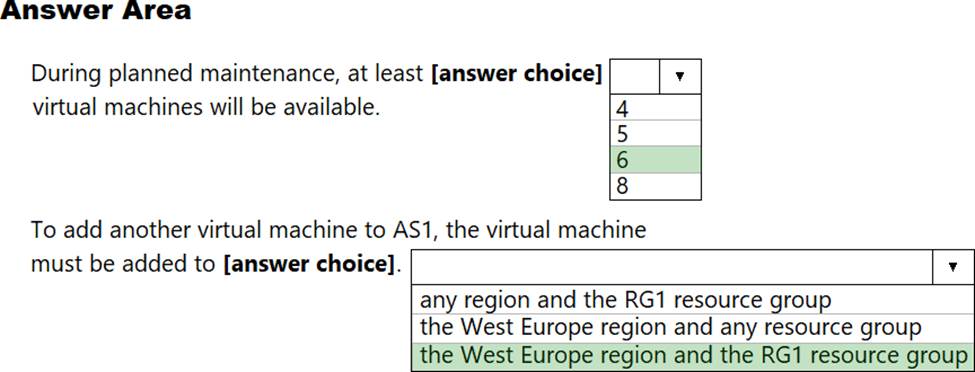Microsoft AZ-303 Microsoft Azure Architect Technologies Online Training
Microsoft AZ-303 Online Training
The questions for AZ-303 were last updated at Dec 21,2025.
- Exam Code: AZ-303
- Exam Name: Microsoft Azure Architect Technologies
- Certification Provider: Microsoft
- Latest update: Dec 21,2025
You download an Azure Resource Manager template based on an existing virtual machine.
The template will be used to deploy 100 virtual machines.
You need to modify the template to reference an administrative password. You must prevent the password from being stored in plain text.
What should you create to store the password?
- A . a Recovery Services vault and a backup policy
- B . an Azure Key Vault and an access policy
- C . an Azure Storage account and an access policy
- D . Azure Active Directory (AD) identity protection and an Azure policy
HOTSPOT
You create and save an Azure Resource Manager template named Template1 that includes the following four sections.
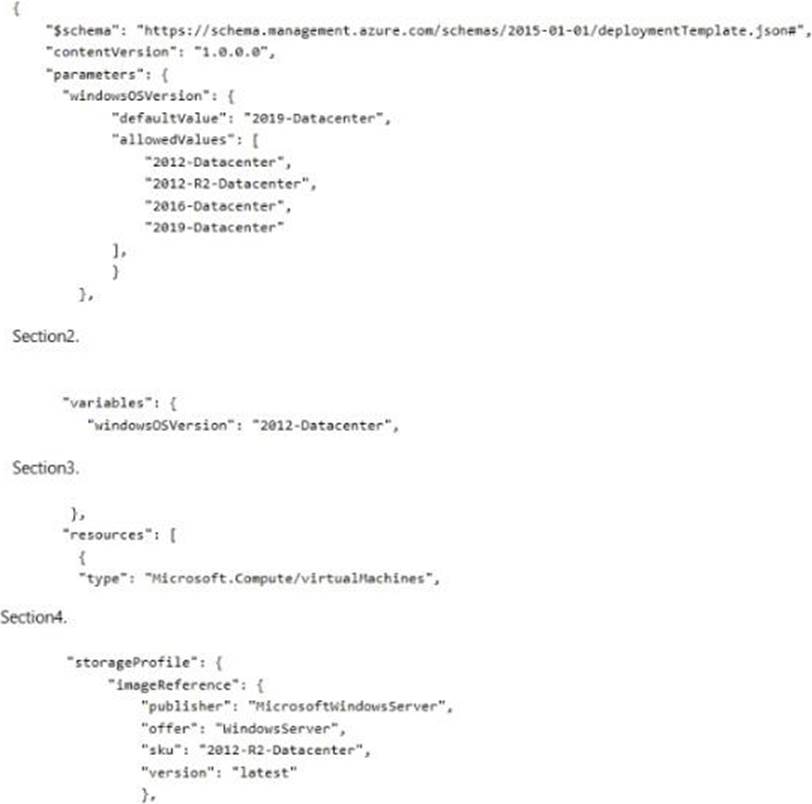
You deploy template1.
For each of the following statement, select Yes if the statement is true. Otherwise, select No. NOTE: Each correct selection is worth one point.

HOTSPOT
You have an Azure subscription that contains multiple resource groups.
You create an availability set as shown in the following exhibit.
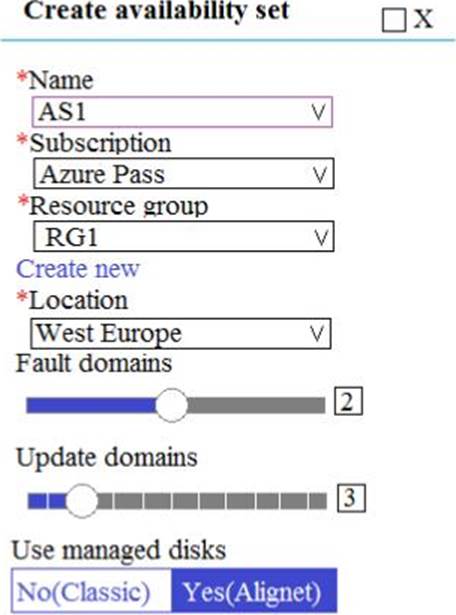
You deploy 10 virtual machines to AS1.
Use the drop-down menus to select the answer choice that completes each statement based on the information presented in the graphic. NOTE: Each correct selection is worth one point.
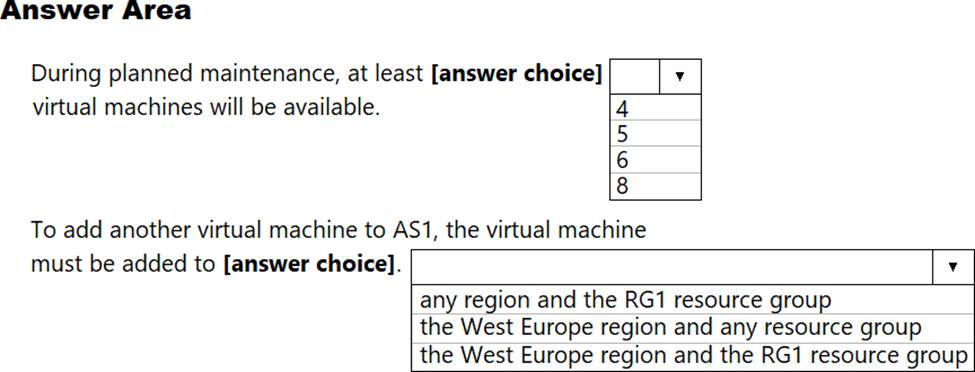
You have an Azure subscription that contains the resources shown in the following table.
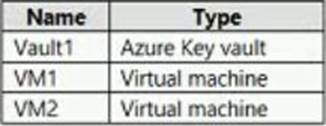
A certificate named Certificate! is stored in Vault!
You need to grant VM1 and VM2 access to Certificate1 by using the same security principal.
What should you do?
- A . Create an Azure Active Directory (Azure AD) user. Create an access policy for Vaultl. Assign the access policy to the user. Configure a user-assigned managed identity forVMl andVM2.
- B . Create a managed identity. Assign the Key Vault Reader role-based access control (RBAC) role for Vault 1 to the managed identity. Configure a system-assigned managed identity for VM1 and VM2.
- C . Create an Azure Active Directory (Azure AD) user. Assign the Key Vault Reader role-based access control (RBAC) role for Vaultl to the user. Configure a user-assigned managed identity for VM1 and VM2.
- D . Create a managed identity. Add the Vaultl access policy to the managed identity.
Configure a user-assigned managed identity for VM1 and VM2.
Note: This question is part of a series of questions that present the same scenario. Each question in the series contains a unique solution that might meet the stated goals. Some question sets might have more than one correct solution, while others might not have a correct solution.
After you answer a question in this section, you will NOT be able to return to it. As a result, these questions will not appear in the review screen.
You manage an Active Directory domain named contoso.local.
You install Azure AD Connect and connect to an Azure Active Directory (Azure AD) tenant named contoso.com without syncing any accounts.
You need to ensure that only users who have a UPN suffix of contoso.com in the contoso.local domain sync to Azure AD.
Solution: You use Synchronization Rules Editor to create a synchronization rule.
Does this meet the goal?
- A . Yes
- B . No
Note: This question is part of a series of questions that present the same scenario. Each question in the series contains a unique solution that might meet the stated goals. Some question sets might have more than one correct solution, while others might not have a correct solution.
After you answer a question in this section, you will NOT be able to return to it. As a result, these questions will not appear in the review screen.
You manage an Active Directory domain named contoso.local.
You install Azure AD Connect and connect to an Azure Active Directory (Azure AD) tenant named contoso.com without syncing any accounts.
You need to ensure that only users who have a UPN suffix of contoso.com in the contoso.local domain sync to Azure AD.
Solution: You use Synchronization Rules Editor to create a synchronization rule.
Does this meet the goal?
- A . Yes
- B . No
Note: This question is part of a series of questions that present the same scenario. Each question in the series contains a unique solution that might meet the stated goals. Some question sets might have more than one correct solution, while others might not have a correct solution.
After you answer a question in this section, you will NOT be able to return to it. As a result, these questions will not appear in the review screen.
You manage an Active Directory domain named contoso.local.
You install Azure AD Connect and connect to an Azure Active Directory (Azure AD) tenant named contoso.com without syncing any accounts.
You need to ensure that only users who have a UPN suffix of contoso.com in the contoso.local domain sync to Azure AD.
Solution: You use Synchronization Rules Editor to create a synchronization rule.
Does this meet the goal?
- A . Yes
- B . No
Note: This question is part of a series of questions that present the same scenario. Each question in the series contains a unique solution that might meet the stated goals. Some question sets might have more than one correct solution, while others might not have a correct solution.
After you answer a question in this section, you will NOT be able to return to it. As a result, these questions will not appear in the review screen.
You manage an Active Directory domain named contoso.local.
You install Azure AD Connect and connect to an Azure Active Directory (Azure AD) tenant named contoso.com without syncing any accounts.
You need to ensure that only users who have a UPN suffix of contoso.com in the contoso.local domain sync to Azure AD.
Solution: You use Synchronization Rules Editor to create a synchronization rule.
Does this meet the goal?
- A . Yes
- B . No
Note: This question is part of a series of questions that present the same scenario. Each question in the series contains a unique solution that might meet the stated goals. Some question sets might have more than one correct solution, while others might not have a correct solution.
After you answer a question in this section, you will NOT be able to return to it. As a result, these questions will not appear in the review screen.
You manage an Active Directory domain named contoso.local.
You install Azure AD Connect and connect to an Azure Active Directory (Azure AD) tenant named contoso.com without syncing any accounts.
You need to ensure that only users who have a UPN suffix of contoso.com in the contoso.local domain sync to Azure AD.
Solution: You use Synchronization Rules Editor to create a synchronization rule.
Does this meet the goal?
- A . Yes
- B . No
You have an Azure SQL database named DB1.
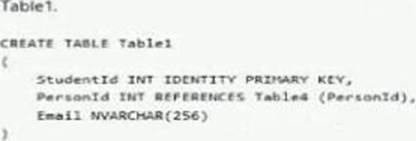
You plan to create the following four tables in DB1 by using the following code:
- A . Table 1
- B . Table 2
- C . Table 3
- D . Table 4
Latest AZ-303 Dumps Valid Version with 206 Q&As
Latest And Valid Q&A | Instant Download | Once Fail, Full Refund


